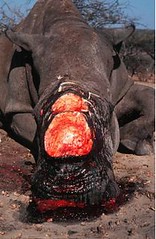 根據南非政府在3日於普里托利亞發表的第四屆全國執法效能報告中指出,2010年4月至2011年3月之間,南非有214名涉嫌盜獵犀牛的人被補,並有16人因為與野生動物官員發生武裝衝突時死亡。
根據南非政府在3日於普里托利亞發表的第四屆全國執法效能報告中指出,2010年4月至2011年3月之間,南非有214名涉嫌盜獵犀牛的人被補,並有16人因為與野生動物官員發生武裝衝突時死亡。
這份南非環境事務部的報告顯示,214名盜獵嫌疑犯中,有92人在克魯格國家公園(Kruger National Park)被補,克魯格國家公園內有南非最大的黑犀牛與白犀牛族群。
另一份於3日發表的報告顯示,過去10個月來,南非被殺害的犀牛數量已經超過2010年。據南非國家公園聯盟(SANPARKS)的統計顯示,2011年至今,已有341頭犀牛受害,高於2010年的333頭。
SANPARKS的數字顯示,在過去的12年間,共有999頭犀牛在南非被殺害。
根據國際保育組織世界自然基金會(WWF)以及野生動物貿易監控網絡(TRAFFIC)一份新的犀牛死亡統計聯合聲明中指出,越南對犀牛角的大量需求,造成了南非的犀牛盜獵問題。
 南非一直是盜獵者目光的焦點,因為那裡有世界最大的犀牛族群。但整個非洲的犀牛盜獵問題在近幾年急遽上升,使保育當局與非政府組織讓族群增長這樣得來不易的保育成果受到威脅。
南非一直是盜獵者目光的焦點,因為那裡有世界最大的犀牛族群。但整個非洲的犀牛盜獵問題在近幾年急遽上升,使保育當局與非政府組織讓族群增長這樣得來不易的保育成果受到威脅。
據華盛頓公約(CITES)秘書處估計,全非洲在2000年至2005年間約有18000頭犀牛,每個月有3頭犀牛被非法獵殺。絕大多數種類的犀牛都被列入CITES的附錄一中,禁止對犀牛的任何部位進行商業性國際貿易。
首次的犀牛到獵警訊發生在2008年,當時有83頭犀牛死亡。然後在2010年,單單克魯格國家公園就有146頭犀牛被盜獵。
南非政府正設立一個中期性的野生動物犯罪反應部隊,與SANPARKS、南非警政署、國家檢察機關、以及國防單位協同調查與犀牛角有關的犯罪案件。
 環境事務部表示,犀牛盜獵問題已被提高到最高的安全管理層級。國家聯合委員會同意,將犀牛行動放入國家聯合行動以及情報機構的常設議題內。
環境事務部表示,犀牛盜獵問題已被提高到最高的安全管理層級。國家聯合委員會同意,將犀牛行動放入國家聯合行動以及情報機構的常設議題內。
2010年華盛頓公約締約國大會中,各成員國作出了結論表示,犀牛被盜獵問題的增加是因為越南對犀牛角需求大幅增加的緣故。執法效能雖有增加,但仍然不夠防止盜獵或阻止組織犯罪集團走私犀牛角。
雖然沒有證據顯示,犀牛角能夠治療癌症或其他疾病,正規傳統中藥成分當中也已經不以犀牛角入藥,但犀牛角越南以及亞洲其他地區對犀牛角作為藥用的需求仍不斷在增加。
這樣的需求導致越南的爪哇犀牛滅絕,越南最後一隻爪哇犀牛的屍體於2010年4月被尋獲,身上帶有槍傷且角已被鋸下。
為回應犀牛盜獵危機,南非政府正推動訪問越南,並討論有關犀牛角走私以及狩獵取得白犀牛角合法出口的問題。
今年9月,越南官員組成的代表團訪問了南非,討論增強兩國間執法合作的問題。TRAFFIC則在去年促成了南非有關當局對越南進行類似的訪問。
世界自然基金會全球物種計畫主任Carlos Drews 博士表示,「由於南非國家公園對犀牛的武裝保護很強,盜獵集團很可能會轉陣到職法力較弱的國家,包含一些可能感到措手不及的亞洲國家。」「為了打斷這個非法貿易鏈,從來源國、中轉國到消費國都應該要加強努力。」
保育當局以及非政府組織為幫助了犀牛生存,正在與時間賽跑。犀牛的五個種類之中,有三種族群狀況處於滅絕邊緣的極危(CR)狀態。
A total of 214 suspected rhino poachers were arrested in South Africa between April 2010 and March 2011, and 16 were killed in armed conflicts with wildlife officials during that period, according to the government's 4th National Compliance and Enforcement Report released today in Pretoria.
The report by South Africa's Department of Environmental Affairs shows that of the 214 suspected poachers, 92 were arrested in Kruger National Park, which is inhabited by South Africa's largest populations of both white and black rhinos.
A separate report out today shows that more rhinos have been killed in South Africa in the past 10 months than were killed in all of 2010. Statistics from South Africa National Parks show that 341 animals have been lost to poaching so far in 2011, more than the previous record of 333 rhinos poached last year.
Over the past 12 years, SANPARKS figures show, 999 rhinos have been killed in South Africa.
In a joint statement on the new rhino fatality statistics, the international conservation group WWF and the the wildlife trade monitoring network TRAFFIC say that rhino horn demand, largely in Vietnam, is leading to the record poaching levels in South Africa.
South Africa has been the focal point for poachers because it has the largest population of rhinos in the world. But rhino poaching across Africa has risen sharply in the past few years, threatening to reverse hard-won population increases achieved by conservation authorities and nongovernmental organizations during the 20th century.
An estimated three rhinos were illegally killed each month in all of Africa from 2000-2005, out of a population of around 18,000, according to figures from the Convention on International Trade in Endangered Species, CITES. Most rhino species are listed in CITES' Appendix I, which bans any international trade of rhino parts for commercial purposes.
The first alarming spike in rhino poaching occurred in 2008, when 83 rhinos were lost. Then, in 2010, Kruger National Park alone lost 146 rhinos to poaching.
The government also is establishing an interim Wildlife Crime Reaction Unit to investigate rhino-related crimes in cooperation with South Africa National Parks, the South African Police Service, conservation authorities, the National Prosecuting Authority and the Defence Force.
The rhino poaching issue has been elevated to highest security management structures, said the Department of Environmental Affairs. A National Joint Committee agreed to incorporate Operation Rhino as a standing agenda item into the country's National Joint Operational and Intelligence Structure.
At a CITES meeting last year, the member governments concluded that the increase in rhino poaching has been caused largely by demand for horn products in Vietnam. Law enforcement efforts there, while increasing, are not yet sufficient to protect rhinos from poachers or stop the smuggling and sale of their horns by organized crime rings.
Demand for medicinal products containing rhino horn continues to increase in Vietnam and other parts of Asia although rhino horn has no proven ability to treat cancer or any other disease and is no longer a part of the official Chinese traditional medicine pharmacopeia.
This demand has led to the extinction of the Javan rhino in Vietnam. The carcass of Vietnam's last Javan rhino was found in April 2010 with a gunshot wound and without its horn.
As part of its response to the rhino poaching crisis, the government of South Africa is facilitating a visit to Vietnam to discuss issues of concern regarding the smuggling of rhino horns and the legal export of sport-hunted white rhino trophies.
In September, a delegation of Vietnamese officials visited South Africa to discuss enhancing law enforcement cooperation between the two countries. Last year, TRAFFIC facilitated a similar visit to Vietnam for South African authorities.
"Since armed protection for rhinos in South African national parks is strong, poaching syndicates are likely to shift to countries with weaker enforcement power, including possibly Asian countries that may be caught off-guard," said Dr. Carlos Drews, Global Species Programme director at WWF. "To break the illegal trade chain, governments in source, transit and consumer countries must all scale up their efforts."
Conservation authorities and NGOs are racing against time to help rhinos survive. Of the five species of rhinoceros, three are critically endangered, the highest level of threat before extinction.


